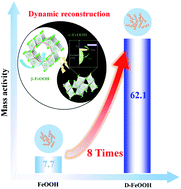Dynamic structural transformation induced by defects in nano-rod FeOOH during electrochemical water splitting†
Abstract
Defect engineering is a prevailing strategy for enhancing the oxygen evolution reaction activity for water spitting of electrocatalysts with a single phase or single metal; however, the exact role of defects in the improvement of catalytic activity remains unclear. Although Fe-based catalysts, such as unary FeOOH compounds, suffer from insufficient activity, they are promising catalysts due to their low cost, rich redox properties and low toxicity. In this work, a unique defect-rich nanorod FeOOH catalyst (D-FeOOH) is rationally constructed by simple electron beam irradiation, which enhances the mass activity by 8 times compared with that for pristine FeOOH and achieves the highest rank among unary Fe catalysts reported to date. In situ Raman and hard X-ray absorption spectroscopic studies reveal that defects during the OER activation process can speed up the dynamic reconstruction from single β-FeOOH to a mixed α/β-FeOOH phase and modulate the ultimate atomic ratio of the mixed phase, which enhances the electrochemical performance. This work provides insight into the defect mechanism in FeOOH by accelerating the dynamic structural evolution during the OER process.



 Please wait while we load your content...
Please wait while we load your content...